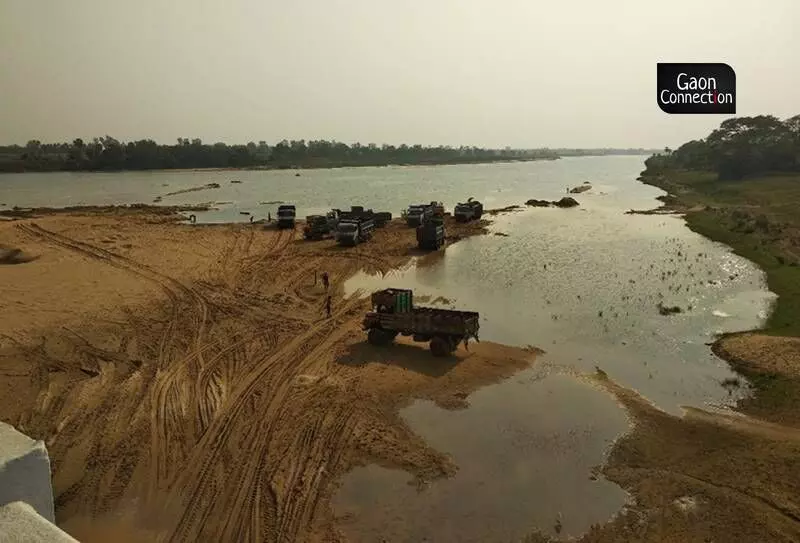Odisha: NGT penalises Rs 360 million for mining sand 240 times above permissible limit
Taking cognizance of the illegal mining of sand on the Budhabalanga river bed in Odisha's Mayurbhanj district, the National Green Tribunal's East Zone has found flouting of regulations of multiple grounds. The tribunal also mentioned that the state authorities have been shielding the accused in the investigation. Details here.
 Ashis Senapati 5 Sep 2022 2:20 PM GMT
Ashis Senapati 5 Sep 2022 2:20 PM GMT

Sand mining operation during monsoon seasons while the same is prohibited but the operators were mining sand in the prohibited period nevertheless. All photos by Sankar Pani
In its order dated August 30, the National Green Tribunal (NGT) came down heavily on two persons for illegal mining of sand at the Budhabalanga river bed in Odisha's Mayurbhanj district at three locations — Mahupura, Dingiria and Arapata which fall under Bada Sahi tehsil. The tribunal has imposed a fine of Rs 360 million for multiple violations of its rules in place to protect the environment.
"Though it is stated that FIR [first information report] has been lodged against Pradeep Kumar Bindhani and Krupasindhu Singh, there is nothing on record to show that FIR has been lodged against Mamtaj Maharana, tehsildar, Badasahi, Mayurbhanj," the bench consisting of Justice B. Amit Sthalekar and Justice Saibal Dasgupta stated in its order.
"We fail to understand as to why the State Respondents are shielding Maharana and all that has been said is that investigation is pending against her and department proceedings have been initiated against her which are pending and she is under suspension," the bench added.
The bench concluded that when the mining permissible limit is only nine cubic metres [CM] per day as per mining plan and annual sand mining capacity is 2,000 CM, the lessee is extracting around 2,295 CM per day and 4,81,900 CMs per year which is around 240 times of the permissible limit.
The tribunal has imposed a fine of Rs 360 million for multiple violations of its rules in place to protect the environment.
The tribunal mentioned that it is established that the lessees and the tehsildar [revenue officer] were prima facie acting in 'connivance in theft and pilferage' of sand from the sand beds in question, thus, 'causing theft of several crores of State Revenue'. The case was petitioned by a local resident named Radhamohan Singh, native to Chhelia village in Mayurbhanj.
Flouting of multiple clearances
The allegations against the accused also mentioned that Environmental Clearance (EC) was granted on February 4, 2017 and Consent to Operate (CTO) was granted on May 31, 2017which was valid only up to March 31, 2021 and therefore, the sand mining beyond that date is illegal.
The petitioner argued that there has been no monitoring of the quantity of sand excavated and GPS [global positioning system], tracking of vehicles, Electronic Transit Pass, CCTV [closed circuit television camera] in the mining site as prescribed in environmental impact assessment [EIA] Notification dated January 15, 2016.
"Vehicular Transportation through densely populated villages and rural roads constructed by the Pradhan Mantri Gram Sadak Yojana (PMGSY) and on the basis of the pavement strength and carrying capacity, the Rural Development Department has fixed signage as 'Heavy Vehicles Prohibited'," the petitioner argued.
He added that the carrying capacity of the roads has not been assessed and as such the existing road cannot withstand the pressure of hundreds of sand loaded heavy vehicles.
Also, sand mining operation during monsoon seasons while the same is prohibited but the operators were mining sand in the prohibited period nevertheless," he stated.
"This is the highest ever fine imposed in the state for illegal sand mining. The unauthorised sand mining is turning out to be a lucrative industry in many riverside villages in the state. The sand lifting has reached a feverish pace in recent days due to huge demand for the river-sand by the construction companies. Officially, sand mining is currently carried out only in a few places but there are many places where the sand mafias are lifting sand illegally and the officials are helpless in checking illegal sand mining elsewhere in the rivers ," Sankar Pani, the lawyer representing the petitioner, told Gaon Connection.
Also, Prafulla Samantray, an Bhubaneswar-based environmentalist told Gaon Connection that the law and order situation has deteriorated in many riverside villages in the state as many groups of sand mafias have been clashing with each other.
"Every day, hundreds of tractors and trucks are allowed to enter the village roads to carry sand from the rivers. The village roads near many sand mining areas are in bad condition due to plying of heavy vehicles and spilling of sand from uncovered vehicles. Heaps of sand dot the entire villages which also creates problems for the rural residents," he said.
Bloody world of India's illegal sand mining
As per the New Delhi-based non-governmental organisation [NGO] named South Asia Network on Dams, Rivers and People (SANDRP), between January 2019 and November 2020, more than eight people every month have lost their lives in the country due to illegal sand mining.
As per the data compiled by SANDRP, 193 people have died due to illegal river sand mining incidents/accidents in India.
"We have scanned news reports from various states to compile this data on deaths due to illegal sand mining in the country. But 193 deaths since last January is a conservative estimate as not all such deaths get reported," Bhim Singh Rawat, associate coordinator of SANDRP told Gaon Connection on November 23, 2020.
"Majority of deaths related to illegal sand mining are of children who fall in illegal sand mining pits and die. Second reason for such deaths is rash driving by trucks transporting the mined sand," he added.
According to the Sand Mining Framework, 2018 , there is a shortage of sand in the country. It estimated that the demand for sand in India is around 700 million tonnes (in 2017) and it is increasing at the rate of six-seven per cent annually.
Also, as per the United Nations Environment Programme (UNEP), the global demand for sand and gravel stands between 40 billion and 50 billion tonnes annually, and its scarcity is an emerging global crisis. The demand for sand is only expected to rise. And high demand and limited supply is leading to sand wars and killings.
#sandmining #illegal sand mining #Odisha
More Stories




